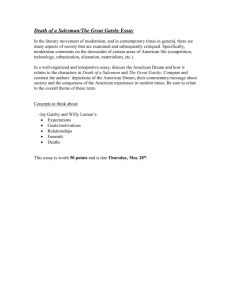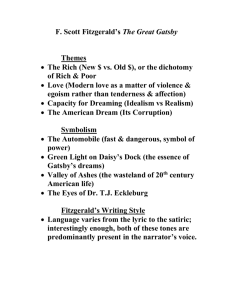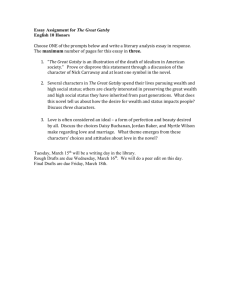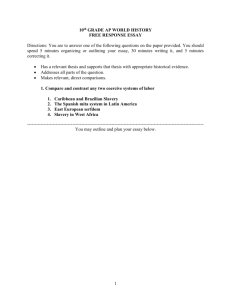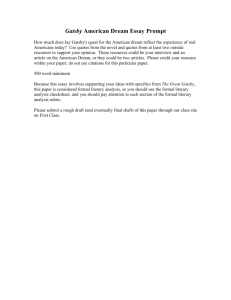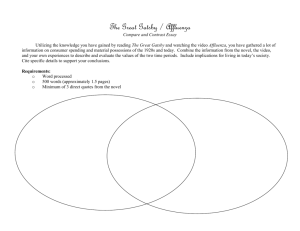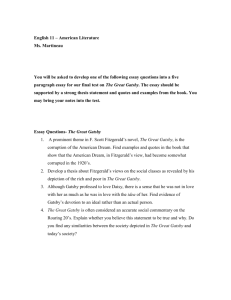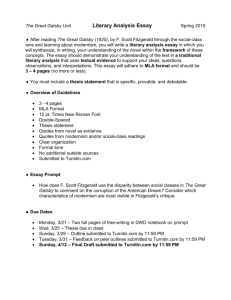Purpose : You will analyze Fitzgerald's writing to explain how your
advertisement
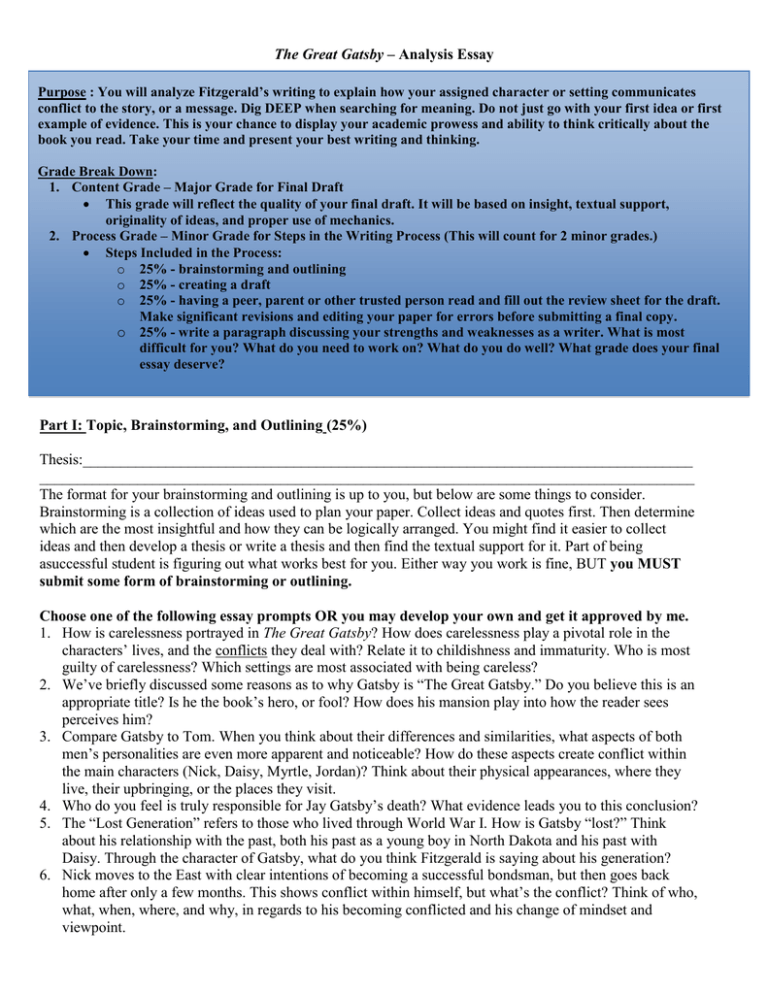
The Great Gatsby – Analysis Essay Purpose : You will analyze Fitzgerald’s writing to explain how your assigned character or setting communicates conflict to the story, or a message. Dig DEEP when searching for meaning. Do not just go with your first idea or first example of evidence. This is your chance to display your academic prowess and ability to think critically about the book you read. Take your time and present your best writing and thinking. Grade Break Down: 1. Content Grade – Major Grade for Final Draft This grade will reflect the quality of your final draft. It will be based on insight, textual support, originality of ideas, and proper use of mechanics. 2. Process Grade – Minor Grade for Steps in the Writing Process (This will count for 2 minor grades.) Steps Included in the Process: o 25% - brainstorming and outlining o 25% - creating a draft o 25% - having a peer, parent or other trusted person read and fill out the review sheet for the draft. Make significant revisions and editing your paper for errors before submitting a final copy. o 25% - write a paragraph discussing your strengths and weaknesses as a writer. What is most difficult for you? What do you need to work on? What do you do well? What grade does your final essay deserve? Part I: Topic, Brainstorming, and Outlining (25%) Thesis:_________________________________________________________________________________ _______________________________________________________________________________________ The format for your brainstorming and outlining is up to you, but below are some things to consider. Brainstorming is a collection of ideas used to plan your paper. Collect ideas and quotes first. Then determine which are the most insightful and how they can be logically arranged. You might find it easier to collect ideas and then develop a thesis or write a thesis and then find the textual support for it. Part of being asuccessful student is figuring out what works best for you. Either way you work is fine, BUT you MUST submit some form of brainstorming or outlining. Choose one of the following essay prompts OR you may develop your own and get it approved by me. 1. How is carelessness portrayed in The Great Gatsby? How does carelessness play a pivotal role in the characters’ lives, and the conflicts they deal with? Relate it to childishness and immaturity. Who is most guilty of carelessness? Which settings are most associated with being careless? 2. We’ve briefly discussed some reasons as to why Gatsby is “The Great Gatsby.” Do you believe this is an appropriate title? Is he the book’s hero, or fool? How does his mansion play into how the reader sees perceives him? 3. Compare Gatsby to Tom. When you think about their differences and similarities, what aspects of both men’s personalities are even more apparent and noticeable? How do these aspects create conflict within the main characters (Nick, Daisy, Myrtle, Jordan)? Think about their physical appearances, where they live, their upbringing, or the places they visit. 4. Who do you feel is truly responsible for Jay Gatsby’s death? What evidence leads you to this conclusion? 5. The “Lost Generation” refers to those who lived through World War I. How is Gatsby “lost?” Think about his relationship with the past, both his past as a young boy in North Dakota and his past with Daisy. Through the character of Gatsby, what do you think Fitzgerald is saying about his generation? 6. Nick moves to the East with clear intentions of becoming a successful bondsman, but then goes back home after only a few months. This shows conflict within himself, but what’s the conflict? Think of who, what, when, where, and why, in regards to his becoming conflicted and his change of mindset and viewpoint. 7. Fitzgerald hints on the conflicting people, mindsets, and attitudes that exist between the West and East, in regards to both the Eggs and America itself. How do these conflicts affect some of the characters? Does it affect them differently? Why? What’s this difference say about those characters? 8. Why doesn’t F. Scott Fitzgerald allow Gatsby to capture his dream? What was the author’s purpose in this decision? Part II: Drafting (25%) You must submit a first draft of your essay. You can handwrite or type it. This must be turned in before the final draft, so it can be used later to reveal the significant changes you made during the writing process. Part III: Essay Review (25%) 25% of your process grade will come from having a peer, parent or other trusted person read and comment on your draft. You can use the “Essay Review Sheet” (available on my website) to ask a peer, parent or other trusted person to read your essay and answer the questions. Or if the person is comfortable commenting directly on your paper, that’s fine too. There just needs to be indication that someone, other than yourself, completed a detailed review of your essay. Edit your rough draft for spelling, grammar, punctuation and mechanics. Part IV: Justifying My Grade (25%) What grade do you HONESTLY feel your essay deserves? Why? How much time did you spend on this paper? What were your strengths and weaknesses? What did you find difficult? What did you find difficult? What do you still need to work on? Remember – your final essay should: o Have an MLA heading an 1” margins o Be double-spaced in Times New Roman o Have a unique title that communicates something about your topic o Have correct internal citations. Remember, citations look like the following: Content “Embedded Quote” (author name, page number). AFTER SUBMITTING YOUR ESSAY TO TURNITIN.COM, YOU SHOULD TURN IN THE FOLLOWING, STAPLED AND IN THIS ORDER: 1. 2. 3. 4. 5. Your final draft Brainstorming/ outlining Your rough draft Peer Response (if you did this on a separate sheet) Grade justification paragraph
